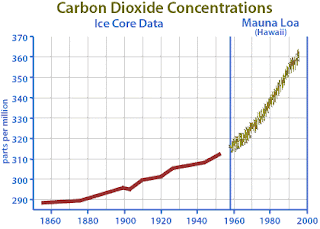Nearly 25 years ago I gave an address at the University of Missouri at Rolla (now Missouri University of Science and Technology) called The Challenge of Global Housekeeping.* Is the atmosphere an infinite sewer into which we may dump all the pollutants we want? I conclude that it appears to be not so, and we have pretty much reached a limit where both anthropogenic global warming and ocean acidification are occurring. Of the 10 warmest years globally, 9 have occurred in this century and the outlier was 1998:**
| Year | Global[66] | Land[67] | Ocean[68] |
|---|---|---|---|
| 2010 | 0.6590 | 1.0748 | 0.5027 |
| 2005 | 0.6523 | 1.0505 | 0.5007 |
| 1998 | 0.6325 | 0.9351 | 0.5160 |
| 2003 | 0.6219 | 0.8859 | 0.5207 |
| 2002 | 0.6130 | 0.9351 | 0.4902 |
| 2006 | 0.5978 | 0.9091 | 0.4792 |
| 2009 | 0.5957 | 0.8621 | 0.4953 |
| 2007 | 0.5914 | 1.0886 | 0.3900 |
| 2004 | 0.5779 | 0.8132 | 0.4885 |
| 2012 | 0.5728 | 0.8968 | 0.4509 |
| Years | Temp. anomaly (°C anomaly (°F anomaly) from 1951–1980 mean) |
|---|---|
| 1880–1889 | −0.274 °C (−0.493 °F) |
| 1890–1899 | −0.254 °C (−0.457 °F) |
| 1900–1909 | −0.259 °C (−0.466 °F) |
| 1910–1919 | −0.276 °C (−0.497 °F) |
| 1920–1929 | −0.175 °C (−0.315 °F) |
| 1930–1939 | −0.043 °C (−0.0774 °F) |
| 1940–1949 | 0.035 °C (0.0630 °F) |
| 1950–1959 | −0.02 °C (−0.0360 °F) |
| 1960–1969 | −0.014 °C (−0.0252 °F) |
| 1970–1979 | −0.001 °C (−0.00180 °F) |
| 1980–1989 | 0.176 °C (0.317 °F) |
| 1990–1999 | 0.313 °C (0.563 °F) |
| 2000–2009 | 0.513 °C (0.923 °F) |
The global human population is still increasing and as I write this, the estimated global population is 7.2 billion. (1) Nearly all this population is contributing to atmospheric pollution in some manner through burning wood or peat if not coal, natural gas, and petroleum or the making of cement, of course with some parts of the global population much more than others. The two countries that contribute the most carbon dioxide to the atmosphere now are China 21.5% and the U.S. 20.2% of the total. (1)
The figure below shows the increase in atmospheric carbon dioxide since 1956 as measured at Mona Loa, Hawaii and is known as the Keeling Curve largely due to the emission of fossil fuels. (2) This reference contains an extensive discussion of carbon dioxide in the Earth's atmosphere. Fossil fuel may be separated from modern vegetation carbon through analysis of carbon isotopes.
See an extensive discussion of this figure in http://en.wikipedia.org/wiki/Keeling_Curve Click on the figure for more clarity.
The increase in carbon dioxide in the atmosphere can not only lead to anthropogenic global warming, but there are indications that the surface ocean water is becoming more acidic.(3)
Ocean acidification is the ongoing decrease in the pH of the Earth's oceans, caused by the uptake of carbon dioxide(CO2) from the atmosphere.[2] An estimated 30–40% of the carbon dioxide released by humans into the atmosphere dissolves into oceans, rivers and lakes.[3][4] To achieve chemical equilibrium, some of it reacts with the water to form carbonic acid. Some of these extra carbonic acid molecules react with a water molecule to give a bicarbonate ion and a hydronium ion, thus increasing ocean "acidity" (H+ ion concentration). Between 1751 and 1994 surface ocean pH is estimated to have decreased from approximately 8.25 to 8.14,[5] representing an increase of almost 30% in H+ ion concentration in the world's oceans.[6][7] Available Earth System Models project that within the last decade ocean pH exceeded historical analogs [8] and in combination with other ocean biogeochemical changes could undermine the functioning of marine ecosystems and many ocean goods and services. (Superscript references are given in the article cited)
This article summarizes only the carbon dioxide contributes to global warming; however, there are other greenhouse gases, the major one being water vapor (because of its abundance), followed by carbon dioxide, methane, nitrous oxide, and ozone. In addition chlorofluorocarbons (Freon) could have a large effect, but their use is curtailed, though their lifetime in the atmosphere is long. One major atmospheric pollutant, sulfur dioxide aerosols, actually cool the atmosphere and is attributed to flattening out global warming.
The biggest effect from anthropogenic global warming will probably be from sea level rise due to thermal expansion of seawater and melting of glaciers and ice caps. Loss of ice cover in the Arctic will not affect sea level, however, it can well disturb many other things, such as ocean circulation and ecosystems. The country most affected by sea-level rise is Bangladesh that has the highest population density in the world though it has contributed little to global warming. Even now they experience floods that cover as much as half the country(4):
The construction of big, modern dykes is problematic as well. If sea levels rise up to 1 metre, "normal” flood waves can be expected to increase from presently 7.4 metres to 9.1 metres.7 This shows clearly that coastal dykes must be very high to really protect the inhabitants.
But the U.S. is not immune to the effects of sea-level rise with the largest effects being where the coastal landmass is also sinking. Storm surges will also have a greater effect because of the higher water level. Even in recent decades, 47% of sandy beaches have seen "critical erosion" and beach replenishments in places like Miami Beach (1976-1981) have been needed owing to coastal erosion due to longshore currents (5). Estimates are (6):
Click on the picture to enlarge.
Twenty-five years later, global housekeeping is more important than ever.
Note added Friday, 02-14-2014: Now it turns out that because methane has 30 times the greenhouse effect as carbon dioxide, losses to the atmosphere in drilling and other leakages may make natural gas worse than diesel fuel (http://www.nytimes.com/2014/02/14/us/study-finds-methane-leaks-negate-climate-benefits of-natural-gas.html?partner=rss&emc=rss&wpisrc=nl_wonk)
References:
* http://stopcontinentaldrift.blogspot.com/2014/01/global-housekeeping-challenge-is-issued.html; Geotimes, 1990, p. 6.
** http://en.wikipedia.org/wiki/Instrumental_temperature_record
(1) http://www.worldometers.info/world-population.
http://en.wikipedia.org/wiki/Carbon_dioxide_in_Earth's_atmosphere
(2) http://en.wikipedia.org/wiki/Carbon_dioxide_in_Earth's_atmosphere; http://www.google.com/search?q=Carbon+Dioxide+in+the+atmosphere&client=safari&rls=en&tbm=isch&tbo=u&source=univ&sa=X&ei=BF_pUvqACOnJsQS3uYCQDg&ved=0CDcQsAQ&biw=1280&bih=902
(3) http://en.wikipedia.org/wiki/Ocean_acidification
(4) http://germanwatch.org/download/klak/fb-ms-e.pdf
(5) http://coastvserosion.wikispaces.com/Miami+Beach+Replenishment+Plan
(6) http://www.epa.gov/climatechange/impacts-adaptation/coasts.html




No comments:
Post a Comment